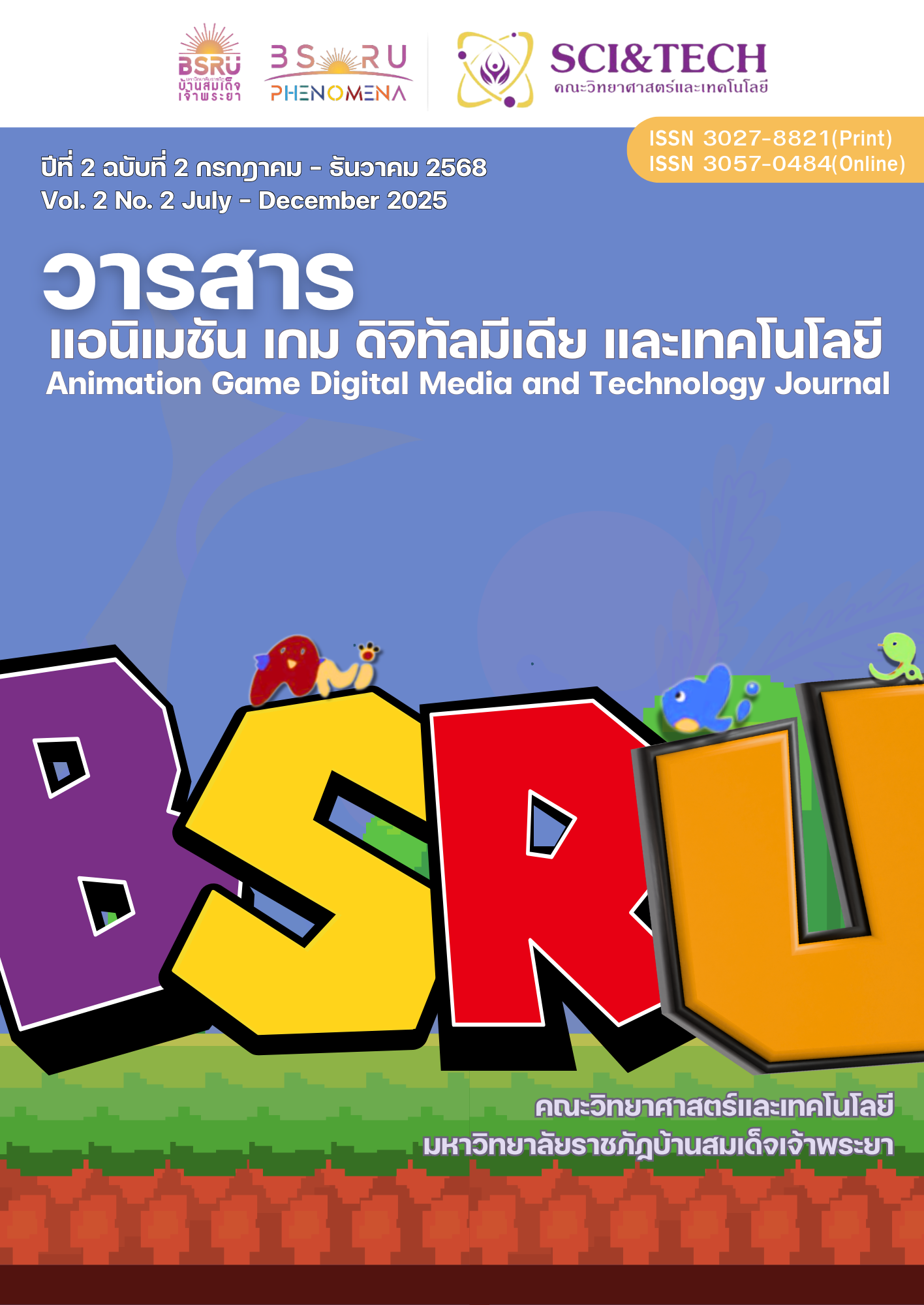การประเมินคุณภาพและยอมรับต้นแบบนวัตกรรมดิจิทัล 2 มิติ ส่งเสริมการเรียนรู้สำหรับห้องเรียนกลับด้านของนักศึกษาระดับปริญญาตรี
Quality Assessment of 2D Digital Innovation Prototype for Enhancing Flipped Classroom Learning for Undergraduate Students
คำสำคัญ:
ต้นแบบนวัตกรรมดิจิทัล 2 มิติ, ส่งเสริมการเรียนรู้ห้องเรียนกลับด้าน, คุณภาพต้นแบบนวัตกรรมดิจิทัล, การยอมรับการใช้ต้นแบบนวัตกรรมดิจิทัลบทคัดย่อ
การวิจัยครั้งนี้มีวัตถุประสงค์ เพื่อประเมินคุณภาพและการยอมรับการใช้ต้นแบบนวัตกรรมดิจิทัล 2 มิติ ส่งเสริมการเรียนรู้ห้องเรียนกลับด้านของนักศึกษาระดับปริญญาตรี กลุ่มตัวอย่าง คือ นักศึกษาสาขาวิชาแอนิเมชัน เกมและดิจิทัลมีเดีย มหาวิทยาลัยราชภัฏบ้านสมเด็จเจ้าพระยา ที่ลงทะเบียนรายวิชาวิทยาศาสตร์กายภาพสำหรับแอนิเมชัน ปีการศึกษา 2/2566 จำนวน 35 คน โดยการเลือกอย่างง่ายด้วยการจับฉลากกลุ่ม เครื่องมือที่ใช้ในการศึกษา ต้นแบบนวัตกรรมดิจิทัล 2 มิติ เรื่อง คลื่นเสียง แบบทดสอบก่อนทดลองและหลังทดลอง แบบประเมินการยอมรับการใช้นวัตกรรมดิจิทัล สถิติที่ใช้ในการวิเคราะห์ข้อมูลประกอบด้วย ค่าเฉลี่ย ส่วนเบี่ยงเบนมาตรฐาน ค่า t-test
ผลการวิจัย พบว่า ผลประเมินคุณภาพเปรียบเทียบจากคะแนนหลังทดลองสูงกว่าก่อนทดลองอย่างมีนัยสำคัญทางสถิติที่ระดับ .05 โดยมีพัฒนาการการเรียนรู้เพิ่มขึ้นร้อยละ 60.45 และผลการยอมรับการใช้ต้นแบบนวัตกรรมดิจิทัล อยู่ในระดับมาก ( = 4.20, S.D. = 0.57) ผลการวิจัยแสดงให้เห็นว่านวัตกรรมดิจิทัลที่พัฒนาขึ้นสามารถนำไปใช้ส่งเสริมการเรียนรู้ห้องเรียนกลับด้านได้อย่างมีคุณภาพ
เอกสารอ้างอิง
Bransford JD, Brown AL, Cocking RR, editors. How people learn: Brain, mind, experience, and school. Washington, DC: National Academy Press; 2000.
Cornelius-White J. Learner-centered teacher-student relationships are effective: A meta-analysis. Rev Educ Res. 2007;77(1):113-43. doi:10.3102/ 003465430298563.
Hannafin MJ, Land SM. The foundations and assumptions of technology-enhanced student-centered learning environments. Instr Sci. 1997;25(3):167-202. doi:10.1023/A:1002997414652
Bergmann J, Sams A. Flip your classroom: Reach every student in every class every day. Eugene, OR: International Society for Technology in Education; 2012.
Kizilcec RF, Halawa S. Flipped classroom and the learning management system: Examining online learning behavior and performance across multiple courses. Comput Educ. 2021;160:104041.
Schneider M, Preckel F. Variables associated with achievement in higher education: A systematic review of meta-analyses. Psychol Bull. 2017;143(6): 565-600. doi:10.1037/bul0000098
Bishop JL, Verleger MA. The flipped classroom: A survey of the research. In: ASEE National Conference Proceedings [Internet]. 2013 Jun 23–26;Atlanta, GA, ASEEI; 2024 [cited 2025 Jun 8];30(9), p.1-18. Paper ID#6219. Available from: https://peer.asee.org/the-flipped-classroom-a-survey-of-the-research. doi:10.18260/1-2--22585
O'Flaherty J, Phillips C. The use of flipped classrooms in higher education: A scoping review. Internet High Educ. 2015;25:85-95. doi:10.1016/j.iheduc. 2015.02.002
Davis F. Perceived usefulness, perceived ease of use, and user acceptance of information technology. MIS Q. 1989;13(3):319-40. doi:10.2307/249008
Venkatesh V. Determinants of perceived ease of use: Integrating control, intrinsic motivation, and emotion into the technology acceptance model. Inf Syst Res. 2000;11(4):342-65. doi:10.1287/isre.11.4.342.11872
Scherer R, Siddiq F, Tondeur J. The technology acceptance model (TAM): A meta-analytic structural equation modeling approach to explaining teacher's adoption of digital technology in education. Comput Educ. 2019;128:13-35. doi:10.1016/j.compedu.2018.09.009
ดาวน์โหลด
เผยแพร่แล้ว
รูปแบบการอ้างอิง
ฉบับ
ประเภทบทความ
สัญญาอนุญาต
ลิขสิทธิ์ (c) 2025 วารสารแอนิเมชัน เกม ดิจิทัลมีเดีย และเทคโนโลยี

อนุญาตภายใต้เงื่อนไข Creative Commons Attribution-NonCommercial-NoDerivatives 4.0 International License.






